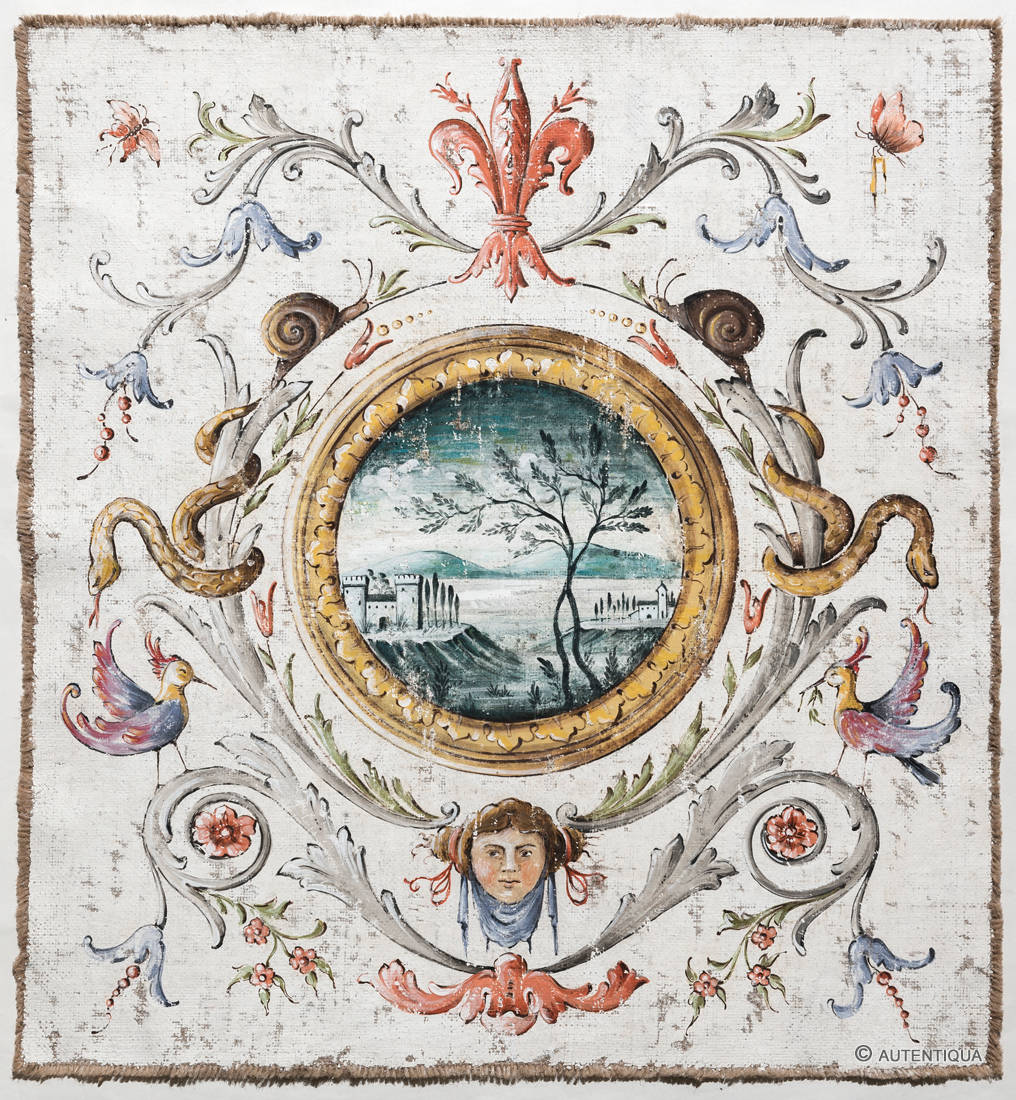Renaissance Painting in the Grotesque Style Between Rome and Florence
Grotesque painting through the centuries, from Nero’s Domus Aurea in Rome to the Autentiqua art workshop in the Florentine Oltrarno neighborhood.

As we write this blog post in the second half of 2021, a multimedia exhibition is under way at the Domus Aurea in the Colosseum archaeological Complex in Rome, to celebrate “The invention of grotesques” by Raphael and his contemporaries.
A Serendipitous Discovery and the Wonderment of a Generation of Artists
Legend has it that at the end of the 15th century, a young man accidentally fell into a crack in the ground on the Oppian hill in Rome. He found himself in a strange “cave”, whose walls were covered in unusual painted figures: they were the frescoed vaults of Nero’s lost Domus Aurea, purposedly buried in the years immediately following the emperor’s death to wipe out his memory by building on top of his lavish mansion the Baths of Titus and Trajan.
Ironically, this damnatio memoriae operation had preserved, by sealing it, the pictorial apparatus of the Neronian palace.
These ancient paintings – for which the term Grotesque was coined precisely because the halls of the Neronian Domus were initially mistaken for grottoes (caves) – captured the imagination of some famous artists such as Filippino Lippi, Sodoma, and Pinturicchio, who arranged to be lowered underground to study them by torchlight, and soon began to reproduce them in their works.
Let us not forget that Pompeii would only come back to light in the mid-18th century, so the rediscovery of Roman paintings from the classical era, virtually unknown until then, had a startling effect.
The elements of that ancient ornamental repertoire inspired many late-Renaissance artists to create a new type of decoration that favored creativity and artistic freedom, in an extreme pursuit of the new, the strange, and the unnatural.
The success of the Grotesque style, however, came with Raphael and with the blooming of Mannerism in the second half of the 16th century, with the widespread use of animals and fantastic elements as one of its most striking features. After a decline in popularity in the Baroque era, the Grotesque style enjoyed a revival in the following centuries and was popular with Rococo, Eclecticist, Liberty (Italian Art Nouveau), and Surrealist artists.
The Fortune of Grotesque Painting in Florence and Tuscany
From Rome, the taste for Grotesques spread quickly across Italy and met with great acclaim throughout Tuscany and particularly in Florence, especially under Grand Duke Francesco I de’ Medici. For example, he commissioned the polychrome Grotesque decoration of the vaults of the main corridor (a loggia at the time) of the Uffizi Gallery.
It is possible to admire this extravagant style in several important public and private palaces across the city and the surrounding countryside, ranging from some Medici villas (Petraia, Poggio a Caiano) to Palazzo Vecchio itself, where Grotesque frescoes appear in several rooms (Green Hall, Lorenzo Hall) as well as in the striking courtyard by Michelozzo.
Examples of monochrome grotesques are the courtyard of the Bartolini Salimbeni Palace in Piazza Santa Trinita and the façade of Palazzo Bianca Cappello in Via Maggio, just a few steps away from the Autentiqua workshop in the Santo Spirito neighborhood.
Autentiqua’s Painted Grotesques
Today, in the Autentiqua workshop we revisit the spirit and ornamental repertoire of Florentine Renaissance Grotesque paintings through a creative process performed with great passion and the utmost care for detail.
Our one-of-a-kind Grotesques are the result of in-depth philological research and of tireless reworkings accomplished through sketches, details, and pictorial finishes.
As such, Autentiqua’s Grotesque paintings are original reinterpretations of a centuries-old repertoire, in which the individual pictorial elements take shape from gestural brushstrokes of matter paint that enhance the contours and volumes, and where the subtle nuances of lean tempera paint create fascinating harmonies of light and shadow.
It is a long and strictly hand-made work, which gives back to the subjects the flavor of the past and the charm of wear, in a harmony that reveals an incredible wealth of details emerging from the color and the matter to endow each piece with the charm and mystery of a precious and timeless work.
Pictured here are a few of our latest creations in the Grotesque style, but don’t forget to browse our online catalogue for more examples of our work, and don’t hesitate to contact us to discuss custom orders with fully tailored subject, size and color palette for one-of-a-kind art pieces to match your exact needs and taste.